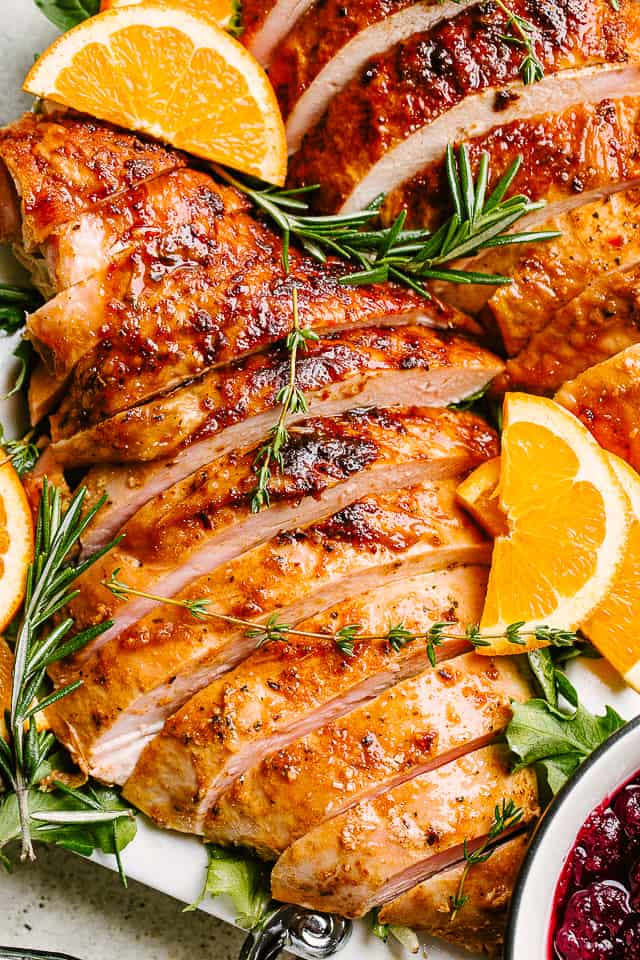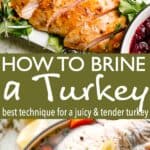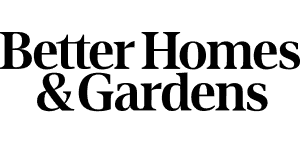This post may contain affiliate links. Please read our disclosure policy.
Brining in a saltwater bath is an extra step that yields a super juicy Thanksgiving turkey that’s full of flavor! I’ll show you how to brine a turkey for roasting using an aromatic and easy turkey brine recipe. Plus, tips for perfect results every time.

Ready to roast the most memorable Thanksgiving turkey yet? This is my simple brine recipe that guarantees a juicy turkey full of moisture and flavor. It’s a savory herb and citrus brine with garlic, citrus zest, mixed herbs, spices, and chicken stock. It couldn’t be easier to make, and I include quick steps on how to brine a turkey, plus helpful tips and tricks!
What Is Brining? (And Why It Works)
Brining is a simple technique using saltwater to lock in moisture and flavor in your turkey (and it works wonders for baked chicken breasts and pork, too!). This approach guarantees a juicy, flavorful result with minimal fuss. Here’s why this brine recipe works so well:
- Salt draws in moisture. Turkey is naturally lean, especially the breast. Brining in a salt solution draws in moisture and flavor, for a juicier, tastier turkey.
- Brining tenderizes the meat. Saltwater breaks down proteins in the meat, making it less likely to overcook.
- Aromatics infuse extra flavor. Including flavor boosters like herbs, citrus, and seasonings is an easy way to take your basic turkey brine (and turkey) to another level!

Ingredients You’ll Need
My favorite turkey brine recipe includes the must-have ingredients (water, salt, and sugar), plus a handful of herbs and citrus to infuse the turkey with even more flavor. Your basic brine includes:
- Warm Water – It’s important that the water is warm (not boiling), allowing the sugar and salt to dissolve. It also makes it easier to steep the herbs and flavor add-ins.
- Kosher Salt –
- Sugar – This can be granulated sugar or brown sugar; it’s up to you.
Flavor Boosters
- Chicken Broth – I recommend using low-sodium or homemade chicken stock, allowing you to adjust the saltiness of your brine to taste. Vegetable broth is another option.
- Garlic – Fresh, smashed cloves are best. I use plenty of garlic!
- Carrot – Thinly sliced. You could add more veggies, too, like chopped celery and onion.
- Lemon – Also sliced for a hint of zesty citrus. Orange slices would also work nicely.
- Orange Peel – Yes, just the peel! The oils in orange peels have loads of flavor. Tear the peel up into pieces.
- Herbs – Whole peppercorns, plus fresh thyme, rosemary, and parsley.
How to Scale for Turkey Size
The recipe, as written, is suitable for a 12 to 20-pound turkey, following a salt-to-liquid ratio of 1 cup of salt per 1 gallon of water. For a smaller turkey, or to brine a turkey breast, you can halve the ingredients. Refer to the recipe card after the post for the full amounts.

Turkey Brining Tips and Tricks
- Make sure that your turkey isn’t previously brined. It should say so on the packaging, or take a look at the ingredients. If the turkey is salt-injected or kosher, it does not need brining.
- Use a large bin that will fit the turkey and liquid. The trick here is to find a container that will also fit inside the fridge. The turkey needs to be refrigerated during the brining process for food safety reasons.
- Make sure the turkey is covered. Top up with additional water or broth, as needed, so the turkey is fully submerged.
- However, if your fridge space is limited, consider brining your turkey in a cooler. Place the brine and turkey in a large brining bag (you can get those at your grocery store or Amazon). Seal the bag closed and place it inside the cooler. Cover with lots of ice and set in a dark, cool place until it’s time to cook.

Brine Time Per Pound of Turkey
As a rule of thumb, aim for 1 hour of brining time per pound of turkey. So, for a 12-pound turkey, expect to brine it for at least 12 hours before cooking. For a wet brine like we use in this recipe, don’t brine for longer than 24-48 hours to avoid the turkey becoming too salty or mushy.
Frequently Asked Questions
Yes! While I recommend using a fresh turkey when possible, if needed, you can defrost a frozen turkey in brine. For a frozen turkey, allow 24 hours of thawing time per 5 pounds of turkey (for a 12-pound turkey, that means 2-3 days in the fridge).
Yes. After the brining period, rinse the turkey with cool water and pat it dry. This is crucial for achieving the perfect roast.
Not necessary! The whole point of a brine is to season the turkey ahead of time. Avoid adding too much, if any, salt afterward.
If you leave a turkey in brine for too long, the meat becomes overly salty and takes on a mushy, spongy texture. Stick to the 1 hour per pound rule!
Pin this now to find it later
Pin It
Turkey Brine Recipe
Ingredients
- 12 to 20 pound turkey
- 1 gallon warm water
- 1 cup kosher salt
- 1 cup granulated sugar
- 4 cups chicken broth
- 10 cloves garlic, smashed
- 1 large carrot, thinly sliced
- 1 large lemon, sliced, slices cut into half-moons
- orange peel of 1 large orange, torn into several pieces
- 1 tablespoon peppercorns
- 4 sprigs fresh thyme
- 4 sprigs fresh rosemary
- ¼ cup fresh parsley leaves
Instructions
- Prepare the brine. Place a gallon of warm water in a large pot, bucket, or bin. Stir in the salt and sugar and continue to stir until dissolved. Then, stir in the chicken broth.
- Add the aromatics. Add garlic, carrot slices, lemon slices, orange peel, peppercorns, thyme, rosemary, and parsley; stir to combine.
- Submerge the turkey. Carefully submerge the turkey in the brine. Add more water, if needed, to make sure the brine covers the turkey entirely.
- Refrigerate. Cover with a plastic bag and top with a heavy item, like a brick or a heavy plate, to keep the turkey submerged. Refrigerate for a minimum of 12 hours and up to 24 to 48 hours.
- *Cooler method: If fridge space is limited, use a cooler. Place the brine and turkey in a large brining bag. Seal the bag closed and place it inside the cooler. Cover with lots of ice and set in a dark, cool place until ready to use.
- Rinse the turkey. When ready to cook, take the turkey out of the brine, rinse it under cold water, and pat it dry with paper towels.
- Cook. Roast the turkey as usual or according to the recipe you are using.
Video
Notes
- Select a turkey that isn’t pre-brined; this should be indicated on the label or ingredient list. Don’t use a kosher, saline-injected, or previously brined turkey.
- Brine for at least 12 hours for optimal flavor.
- Mix 1 cup of salt with 1 gallon of water for the brine, and infuse it with aromatics like rosemary, thyme, parsley, citrus, and garlic.
- Choose a container large enough for the turkey and brine, but make sure it fits in your fridge.
- For tight spaces, use a cooler. Seal the turkey in a brining bag, pack with ice, and store in a cool, dark spot.
- Keep the turkey submerged in the brine with a weighted plate or brick for 12 to 24 hours.
- You might want to use a brining bag for cleanliness and ease of handling, though it’s optional.
- Top up with water or broth if more liquid is needed to cover the turkey.
- For smaller turkeys or turkey breasts, halve the brine mixture.
- For a frozen turkey, immerse it in the brine for up to 3 days; this will simultaneously thaw and season the bird.
- After brining, rinse and dry the turkey well and cook with limited or no additional salt, as it’s already seasoned from the brine.
Nutrition
Nutritional info is an estimate and provided as courtesy. Values may vary according to the ingredients and tools used. Please use your preferred nutritional calculator for more detailed info.
How To Brine A Turkey
Now that you have the best turkey brine recipe on hand, here’s how to brine a turkey, step-by-step:
- Choose a big container. This can be a pot, a bucket, or even a fridge drawer. Anything large enough to hold your turkey and the brine. See the Tips section earlier if you’re using a cooler.
- Prepare the brine solution. Dissolve salt and sugar in a gallon of warm water. Infuse it with chicken stock, garlic, carrots, citrus slices, peppercorns, and herbs.
- Brine the turkey. Submerge your turkey, weigh it down to keep it under the brine, and refrigerate for 12 to 24 hours.
- Rinse and roast. Rinse the turkey, pat it dry, and cook it with minimal salt.
How to Roast a Brined Turkey
Follow my easy roast turkey recipe or any of the suggestions below. When roasting, you may find that a brined turkey cooks quickly, so start checking the internal temperature about an hour before the anticipated end of the cooking time.
Aim for a minimum internal temperature of 165°F in the breast meat before removing your Thanksgiving turkey from the oven.
If you’d rather skip the brine, try my no-brine turkey recipe.









Hi. It’s my first turkey, I’m a noob with this 🙂 All the recommendations say to cook turkey immediately after defrosting. I am confused with how to reconcile this with recipes that require to brine overnight before cooking. Thank you!
Hi there! No worries, you’ve got this! 😊 As long as the turkey stays refrigerated, it’s perfectly fine to brine it after defrosting. If your turkey is still frozen, you can actually put it straight into the brine, and it will defrost as it brines. Just make sure the turkey is fully submerged and kept cold the whole time.
I’ve included these tips and details in the post and recipe card, so feel free to check those out for more info. Let me know if you have any other questions—I’m happy to help!
Hi, I will be trying your brining recipe this year. I was wondering after I brine it should I also use your butter compound on it also when putting it into the oven?
Hi!
Yes, I always do, and it turns out to be delicious. 😊
Use this brine recipe every year for Thanksgiving! It’s SO good!!
That’s great! I’m so happy to hear you use the brine recipe every year for Thanksgiving! Thank YOU! 🙂
This brining recipe is the best!!! I used it for christmas last year and it was a huge hit with the family, so much so that I’ve been nominated to cook the turkey from now on. It was just so tender and flavorful, I will be using this recipe for years to come.